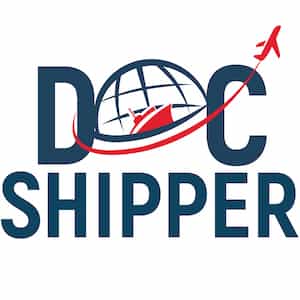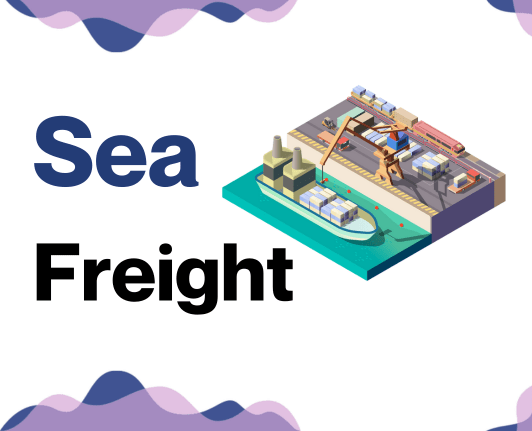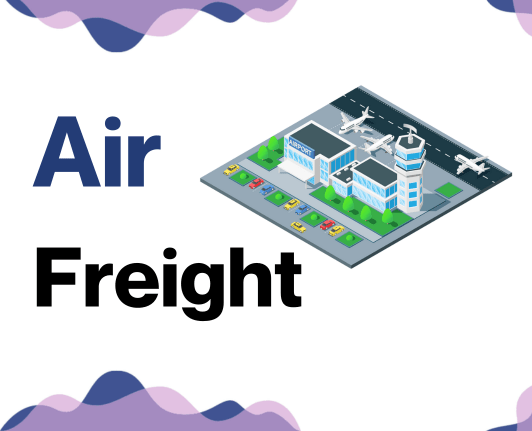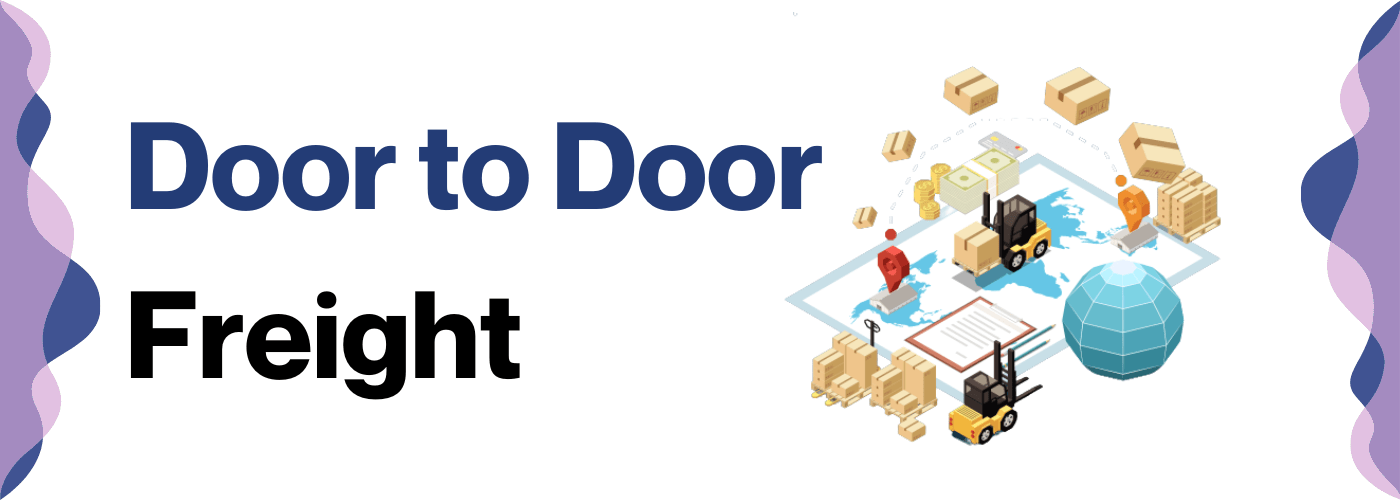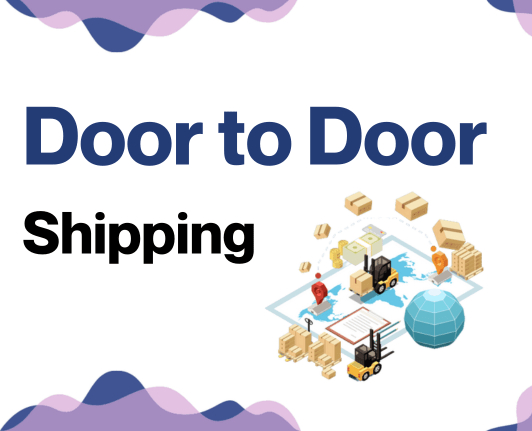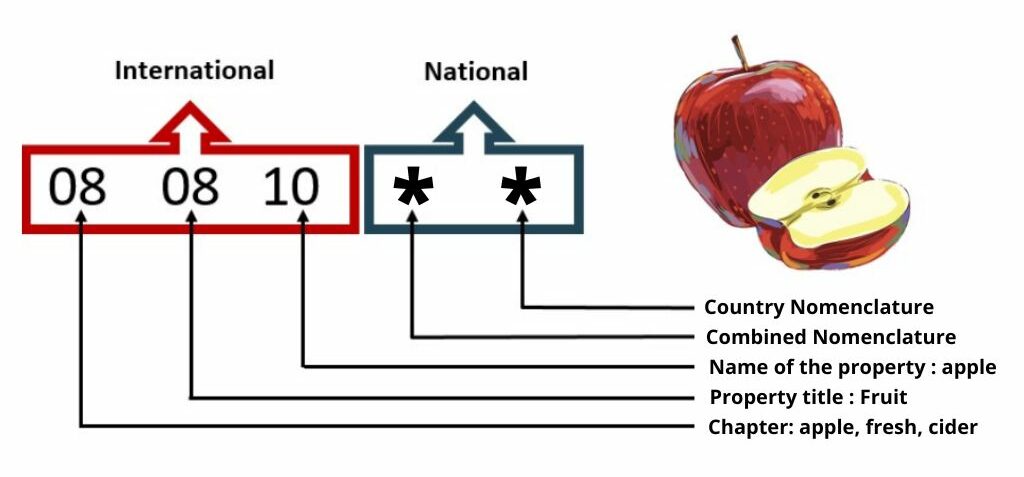Ever tried to fit a Malaysian durian into a Spain-bound suitcase? Not a pretty sight! The process of shipping goods from Malaysia to Spain shares a similar complexity - figuring out the best shipping rates, understanding estimated transit times, and complying with persistent customs regulations.
Throughout this guide, we walk you through these nuances, exploring the sea to sky spectrum of freight options, journeying through the intricacies of customs clearance, the whys and hows of applicable duties and taxes, and imparting profitable advice tailored specifically for business entities.
If the process still feels overwhelming, let DocShipper handle it for you! As an experienced international freight forwarder, we navigate every step of the shipping process with you, turning what might seem like insurmountable challenges into successful outcomes.
Table of Contents
Which are the different modes of transportation between Malaysia and Spain?
Deciding on the best transport method from Malaysia to Spain, land of flamenco, is like choosing the quickest horse in a thrilling derby. Geographical hurdles and the vast sea distance knock out rail and road transport like dominoes. It leaves us with ocean and air freight, two stallions both strong and reliable.
But it's not a one-size-fits-all. Whether you favor the swift speed of the air express or the hefty load-bearing ability of the sea routes depends on your specific cargo needs. Your perfect stallion awaits, no matter the race conditions!
How can DocShipper help?
Struggling with Malaysia to Spain shipping logistics? Stress no more! Docshipper is your trusted companion offering comprehensive shipping solutions. Enjoy a free estimate in under 24 hours. Don't hesitate, our consultants are a call away ready to answer your queries for free. Your smooth shipping experience is one call away!
DocShipper Tip: Sea freight might be the best solution for you if:
- You're dealing with hefty quantities or oversized goods. Sea transport is your go-to for maximizing space without stretching your budget.
- Time sensitivity isn't a concern for your shipment. Ocean freight is known for its leisurely pace, especially when compared to the speed of air or rail.
- Your supply chain connects key international harbors. This positions you to take full advantage of a wide-reaching network of ocean trade routes.
Sea freight between Malaysia and Spain
Ocean shipping, the game-changer in the robust trade ties between Malaysia and Spain, has never been more vital. Solidly connecting Malaysia's bustling Port Klang to the far-reaching Port of Barcelona in Spain, these seaborne channels form lifelines for heavy goods.
One could liken the sea freight to a slow-moving elephant - it might take time, but it can carry immense loads, making it perfect for large-scale commerce. So why do so many business owners still break a sweat when it comes to shipping cargo along this route?
It's like trying to thread a needle in a haystack - it seems straightforward, but without the right tools and techniques, you're in for a rough ride. An array of unseen challenges lurk below the placid surface of sea trade, from misjudged logistics to unanticipated customs regulations.
However, by adhering to certain best practices and keeping an eye out for those devil-in-the-details specifications, the journey becomes far less daunting. Stay docked right here, as we unlock these complexities for you, turning sea waves into smooth sailing!
Main shipping ports in Malaysia
Port Klang
Location and Volume: Located on the Strait of Malacca in Selangor, Port Klang reigns as the largest port in Malaysia, playing host to an impressive shipping volume of over 13.9 million TEUs in 2022.
Key Trading Partners and Strategic Importance: This port is a critical trade connection with major economies such as China, Singapore, the EU, and USA. Its strategic location in Southeast Asia makes it an important shipping link between the East and West.
Context for Businesses: If you're planning to penetrate the ASEAN and APAC markets, Port Klang, with its modern facilities and comprehensive service range, is equipped to handle your logistics needs efficiently.
Port of Tanjung Pelepas
Location and Volume: Situated at the eastern edge of the Strait of Malacca in Johor, the Port of Tanjung Pelepas shipped a record 10.9 million TEUs in 2022, marking it as one of the fastest-growing container ports in the world.
Key Trading Partners and Strategic Importance: Its principal trading partners include China, Singapore, and Hong Kong. The port's strategic importance lies in its proximity to Singapore, providing a direct alternative to the crowded and expensive Port of Singapore.
Context for Businesses: If you're trying to expand your shipping routes while keeping costs competitive, Port of Tanjung Pelepas' strategic advantages position it as an attractive entry point into Southeast Asia.
Penang Port
Location and Volume: Found on Penang Island in the Malacca Strait, this port is northern Malaysia's primary maritime gateway, handling a respectable volume of almost 1.8 million TEUs in 2022.
Key Trading Partners and Strategic Importance: Penang Port has strong trading relationships with India and China. The port's strategic importance comes from its location within the Bayan Lepas Free Industrial Zone, making it central to Malaysia's technology and electrical goods sectors.
Context for Businesses: If you're in the technology or manufacturing sectors seeking a foot in the Malaysian market, Penang Port, located in the heart of one of Malaysia's technological hubs, could offer distinct advantages.
Bintulu Port
Location and Volume: Placed on the South China Sea coast in Sarawak on Borneo Island, Bintulu Port handled an estimated 50.73 million tons of cargo in 2022, making it a strategic point for bulk shipping.
Key Trading Partners and Strategic Importance: As one of the world's main LNG ports, its main trading partners include Asia’s top economies like Japan, Korea, and Taiwan.
Context for Businesses: Businesses dealing with energy commodities that are looking to leverage Asia's energy demands, Bintulu Port's standing as a major LNG shipping point would benefit your trade.
Kuantan Port
Location and Volume: Kuantan Port, situated on the eastern coastline of Peninsular Malaysia, is a multi-purpose port handling varied cargo types from liquid to dry bulk. In 2022, it handled over 32 million freight weight tons of cargo.
Key Trading Partners and Strategic Importance: Key trading partners include China, with whom Malaysia enjoys a well-developed trading relationship. The construction of the New Deep-Water Terminal marks its importance in China’s One Belt and Road Initiative.
Context for Businesses: If you're seeking a strong transport link into China's markets while handling different types of goods, the versatility of Kuantan Port provides a comprehensive shipping solution.
Port of Sepangar
Location and Volume: Located in Sepangar Bay, Kota Kinabalu, this is Sabah's main container port, handling almost 550,000 TEUs in 2022.
Key Trading Partners and Strategic Importance: As the closest Malaysian port to the East, it serves as a strategic trading spot between Malaysia and countries like Japan, China, and South Korea.
Context for Businesses: Shipping to Eastern Asian markets? Port of Sepangar might be a significant part of your shipping logistics, given its strategic location and connections.
Main shipping ports in Spain
Port of Barcelona:
Location and Volume: Located on the northeastern coast of Spain, in Catalonia, Port of Barcelona is the country’s third largest port dealing with approximately 3.5 million TEUs Twenty-Foot Equivalent Units annually.
Key Trading Partners and Strategic Importance: The port has substantial geographic importance due to its access to the Mediterranean Sea, opening up trade routes with different parts of Europe, Africa, and the Middle East. Major trading partners include Italy, China, and Turkey.
Context for Businesses: If you're looking to establish a reliable gateway to Europe, the Port of Barcelona serves as an essential hub, given its abundant connections and high volume of throughput.
Port of Valencia:
Location and Volume: The Port of Valencia, located on the eastern coast of Spain, is the largest Spanish port, with a shipping volume of over 5 million TEUs.
Key Trading Partners and Strategic Importance: Valenica excels in container handling and is strategically located for trade with the Mediterranean and North Africa, with prominent trading partners including China, the United States, and Italy.
Context for Businesses: If you’re involved in large scale commercial operations targeting Europe or Africa, the Port of Valencia's colossal capacity and extensive trade networks make it a hard-to-ignore option.
Port of Algeciras :
Location and Volume: Located near the southernmost tip of Spain, the Port of Algeciras processes nearly 4.5 million TEUs annually, positioning it as the second largest port in Spain.
Key Trading Partners and Strategic Importance: This port has a strategic location at the Gateway of the Mediterranean which facilitates trade with major partners such as China, the United States, and Morocco.
Context for Businesses: For companies aiming to capitalize on trade with the North African market, the Port of Algeciras could provide a geographically advantageous shipping route, owing to its proximity and existing trade relations.
Port of Bilbao :
Location and Volume: The Port of Bilbao, situated in the northern part of Spain, handles over 1 million TEU annually.
Key Trading Partners and Strategic Importance: Bilbao, being positioned on the Cantabrian Sea, bolsters trade primarily with the UK, Germany, and Russia.
Context for Businesses: If your business focus is towards the cooler Northern European markets, Bilbao might fit seamlessly into your logistics plan, given its strategic location and regular routes to these markets.
Port of Las Palmas:
Location and Volume: Port of Las Palmas, located in the Canary Islands, deals with over 1 million TEUs annually.
Key Trading Partners and Strategic Importance: Being geographically closer to Africa, it links the African, European, and American markets. Its key trading partners are located in these areas.
Context for Businesses: Businesses aiming to bridge trade between Africa, Europe, and America will find the Port of Las Palmas a strategic hub owing to its geographic position and robust trade links.
Port of Tarragona :
Location and Volume: The Port of Tarragona, located in northeastern Spain on the Mediterranean coast, experiences a shipping volume of over 200,000 TEUs annually.
Key Trading Partners and Strategic Importance: Tarragona serves as a significant hub in the Mediterranean, fostering trade especially with Italy, France, and the United States.
Context for Businesses: If your operations encompass specific Mediterranean markets, Tarragona, with its focus on this region and its sizable trading volume, could be a crucial part of your shipping strategy.
Should I choose FCL or LCL when shipping between Malaysia and Spain?
When shipping between Malaysia and Spain, selecting between full container load (FCL) and less than container load (LCL), also known as consolidation, is a pivotal decision. This choice influences not only your cost and delivery time, but also the overall success of your shipment.
Because your business is unique, the one size fits all approach doesn't apply here. Let's delve into the differences between FCL and LCL, empowering you to make the most strategic shipping decision. Hold tight, we're about to set sail on a deep-dive into sea freight options!
LCL: Less than Container Load
Definition: LCL, or Less-than-Container Load, refers to a shipment that will not fill an entire standard container. Goods are consolidated with other shippers' goods into one single container for the sea journey.
When to Use: Opt for LCL freight when your cargo is less than 13 to 15 cubic meters (CBM). It offers more flexibility, as you don't have to wait until you have enough goods for a full container. This makes LCL particularly good for low volume or infrequent shippers.
Example: Consider a Spanish premium olive oil producer exporting small quantities to high-end restaurants in Malaysia. Their quarterly shipment might only take up 10 CBM, making LCL shipment the better choice.
Cost Implications: The cost for LCL freight is often higher per unit compared to a full container load (FCL) due to the extra activities like consolidation and deconsolidation. However, it gives you the advantage of not having to pay for space you're not using, making it cost-effective for smaller volumes.
FCL: Full Container Load
Definition: FCL, or Full Container Load, is a type of sea freight shipping where your goods occupy a whole container, be it a 20'ft or 40'ft container.
When to Use: This option is beneficial for large volume shipping - typically when you have more than 13/14/15 cubic meters (CBM) of goods. Apart from the capacity, FCL is also a secure option, providing safety as the container is sealed from origin to destination.
Example: Say you're a furniture retailer in Kuala Lumpur, planning to send a large shipment of chairs to Barcelona. By choosing FCL shipping, you'd occupy an entire container, ensuring your cargo remains untouched during transit.
Cost Implications: It's important to know that while FCL might seem more expensive initially, the cost per unit becomes significantly cheaper when shipping in large volumes. When asking for an FCL shipping quote, remember that you're paying for the whole container, so it's cost-efficient if your shipment occupies the full capacity. However, if your goods only fill half a container, you'll pay for space not utilized, making LCL potentially a more economical option in this case.
Unlock hassle-free shipping
With DocShipper, shipping cargo between Malaysia and Spain can be simple and stress-free. Our team of ocean freight experts aids businesses in assessing factors like shipment size, urgency, and budget, and deciding between consolidation or a full container. We work tirelessly to understand your shipping demands and offer the best fit. Ready to dispel all your cargo shipping woes? Contact us today for a hassle-free freight forwarding experience and receive a free cost estimation!
How long does sea freight take between Malaysia and Spain?
Sea freight transport between Malaysia and Spain averages around 40 to 60 days. This transit time accounts for specific elements such as the ports involved in the shipping process, the weight of the shipment, and the nature of the goods being shipped.
As this is just a general estimate, we highly recommend reaching out to a reliable freight forwarder like DocShipper for an accurate, tailored quote to fit your specific needs.
Here's a general overview of average transit times:
| From (Malaysia) | To (Spain) | Average Transit Time (Days) |
| Port Klang | Port of Barcelona | 20 |
| Port of Tanjung Pelepas | Port of Valencia | 20 |
| Port of Penang | Port of Algeciras | / |
| Bintulu Port | Port of Bilbao | 30 |
*Please keep in mind these are average estimations. For a precise transit time, please consult with DocShipper.
How much does it cost to ship a container between Malaysia and Spain?
Shipping a container from Malaysia to Spain can vary remarkably in cost, from the hundreds to thousands per CBM. The unpredictability of the exact shipping cost stems from multiple factors including the Point of Loading, Point of Destination, the carrier, nature of the goods, and monthly market trends, among others.
Rest assured, our dedicated shipping specialists understand these variables and determine ocean freight rates on a case-by-base basis, ensuring you receive the most economical and value-driven shipping option for your needs. We're all about providing the best service at the best price, tailor-made for your unique scenario.
Special transportation services
Out of Gauge (OOG) Container
Definition: An OOG container refers to Out of Gauge cargo that cannot fit inside a standard shipping container due to its dimensions. They are specially designed to transport large, heavy goods and machinery.
Suitable for: These containers are perfect if your cargo exceeds the standard container size in either length, breadth, height, or weight.
Examples: Machinery, construction equipment, large vehicles, and outsized industrial parts are often shipped in OOG containers.
Why it might be the best choice for you: If you have abnormal-sized cargo that needs shipping between Malaysia and Spain, the OOG container offers an adaptable and efficient solution.
Break Bulk
Definition: Break bulk is a method where goods are loaded individually onto the vessel rather than being placed in containers. They are often bundled, shrink-wrapped, or palletized for easy handling.
Suitable for: It's ideal for awkwardly shaped or oversized items that cannot be containerized.
Examples: Goods often shipped this way include construction equipment, steel girders, or wind turbines.
Why it might be the best choice for you: If your cargo doesn't fit into standard containers and isn't excessively heavy or large, break bulk shipping maintains flexibility without the need for specialized containers.
Dry Bulk
Definition: Dry bulk involves shipping loose cargo load commodities that are poured directly into the bottom of a ship's hold rather than loaded in a container.
Suitable for: This method is often used for high volume, uniform materials that can endure exposure to the elements.
Examples: Typical dry bulk cargo includes coal, grains, or minerals.
Why it might be the best choice for you: If your business deals with large quantities of granular cargo such as grains or coal, dry bulk shipping between Malaysia and Spain offers an economical and efficient option.
Roll-on/Roll-off (Ro-Ro)
Definition: Roll-on/Roll-off shipping, known as the ro-ro vessel method, involves vehicles directly being driven on and off the vessel on their wheels or using a platform.
Suitable for: This method is generally used for self-propelled, wheeled cargo like cars, trucks, trailers, or railway carriages.
Examples: Automobile manufacturers frequently use Ro-Ro shipping to transport vehicles globally.
Why it might be the best choice for you: If you're in the automotive industry and need an efficient way to ship uncontainerized vehicles, Ro-Ro can offer a more efficient and cost-effective solution.
Reefer Containers
Definition: Reefer containers or refrigerated containers are climate-controlled and used for goods which need to be transported at a constant temperature.
Suitable for: They are ideal for perishable goods like fruits, vegetables, dairy products, or medical supplies.
Examples: Fresh fruits from Malaysia like durians and mangosteens can be shipped to Spain in reefer containers to maintain their freshness.
Why it might be the best choice for you: If you're in the business of perishable goods, Reefer containers ensure your products remain in optimal condition throughout their journey from Malaysia to Spain.
Figuring out your best shipping option between Malaysia and Spain can be tricky. But don't worry, at DocShipper, we simplify this process for you, providing expert advice and tailor-made solutions. Don't hesitate to reach out to us for a free shipping quote in less than 24h. Our dedicated team will help you choose the shipping method that best suits your business.
DocShipper Tip: Air freight might be the best solution for you if:
- You're pressed for time or facing a non-negotiable deadline. Air freight delivers unparalleled speed when it comes to transit times.
- Your shipment is modest in size, falling under 2 CBM. Air freight is particularly well-suited for these smaller consignments.
- Your supply chain includes destinations that are off the beaten maritime or rail paths. Air freight gives you access to a comprehensive global airport network.
Air freight between Malaysia and Spain
When it comes to swiftly zooming your high-value electronics or time-sensitive fashion wear from the lively ports of Malaysia to the vibrant markets of Spain, air freight often hits the bullseye. It brings speed, reliability, and cost-effectiveness to the table for small, precious cargo, much like an express mail service, only for international trade.
A classic example: Your latest haute couture collection reaching Barcelona just in time for the fashion show, all thanks to air freight.
However, shippers may trip over unseen hurdles when making the leap towards air freight. Imagine you're baking a cake, and you forget to check the weight of your ingredients. You end up with a sticky debacle instead of a fluffy delight.
Similarly, not using the correct weight formula for your shipment or overlooking best practices can pile on unexpected costs. In this guide, we will guide you away from these pitfalls, keeping your shipping costs as light as air.
Air Cargo vs Express Air Freight: How should I ship?
Getting your goods from Malaysia to Spain swiftly and safely is the crux of your business, and air transport makes that possible. Think of air cargo as booking a seat for your shipment on a commercial flight, while express air freight is like hiring a private jet dedicated only to your goods. Now let's drill down into the benefits and drawbacks of each, so you can make an informed decision!
Should I choose Air Cargo between Malaysia and Spain?
Opting for air cargo between Malaysia and Spain can be a cost-effective and reliable choice if your shipment weighs between 100-150 kg (220-330 Lbs). Major airlines like Malaysia Airlines and Iberia offer substantial freight services, ensuring reliable shipping while keeping an eye on your budget.
However, expect longer transit times as airlines operate on fixed schedules. This option becomes particularly attractive if your freight is not extremely time-sensitive, allowing you to benefit from the cost-effectiveness of scheduled routes.
Should I choose Express Air Freight between Malaysia and Spain?
Express air freight, a specialized service offered by courier companies such as FedEx, UPS, and DHL, employs dedicated cargo planes without passengers for rapid, direct delivery.
Exceptionally suited for transporting your cargo under 1 cubic meter (CBM) or weighing between 100-150 kg (220-330 lbs), this option ensures a speedy, efficient and hassle-free shipment process from Malaysia to Spain.
Why wait, when your business can benefit from transporting smaller, urgent consignments more speedily? Choosing express air freight amplifies your business agility, responding swiftly to market dynamics.
Main international airports in Malaysia
Kuala Lumpur International Airport
Cargo Volume: Approximately 726,230 metric tons annually.
Key Trading Partners: Primarily China, Germany, United States, and Singapore among others.
Strategic Importance: As the busiest airport in Malaysia, KLIA is centrally located and provides excellent links to the Asia-Pacific region.
Notable Features: Housing a wide variety of cargo services, offers facilities like animal hotels, a free commercial zone, express parcel and mail services, and temperature-controlled areas.
For Your Business: With considerable cargo capacities and superb connectivity, KLIA facilitates smooth handling of large volumes, making it crucial for businesses planning comprehensive shipping strategies.
Penang International Airport
Cargo Volume: Approximately 171,500 metric tons per year.
Key Trading Partners: Primarily trade with Asia-Pacific countries, Europe, and America.
Strategic Importance: The third busiest airport in Malaysia, play an essential role in the northern region's cargo shipping industry.
Notable Features: Offers state-of-the-art infrastructure and a free industrial zone to expedite business operations.
For Your Business: If your shipping strategy involves quick turnaround times and cost-effective operations, Penang International Airport is a reliable option.
Sultan Abdul Aziz Shah Airport
Cargo Volume: Operates a small volume but is highly efficient.
Key Trading Partners: Locally focused with increasing international connections.
Strategic Importance: Located close to Kuala Lumpur, it operates a lot of domestic cargo and has a growing number of international cargo airlines.
Notable Features: No storage charge for the first 24 hours, offers secure and efficient cargo handling services and a free trade zone.
For Your Business: This airport is ideal for businesses that focus on local cargo shipments but has the potential for international operations with its growing global connections.
Senai International Airport
Cargo Volume: Approximately 7,700 metric tons annually.
Key Trading Partners: Primarily trades within the Asia-Pacific region.
Strategic Importance: Located in one of the country's key economic regions, it has significant potential for growth.
Notable Features: Houses a Free Zone with a one-stop logistics hub and a modern cargo terminal equipped with cold room facilities.
For Your Business: If your business requires advanced logistics solutions with potential for growth, Senai International Airport offers niche advantages.
Kuching International Airport
Cargo Volume: Moves around 22,500 metric tons of cargo per year.
Key Trading Partners: Trades primarily with Asian countries.
Strategic Importance: Being the fourth busiest airport in Malaysia, Kuching International plays an important role in the Borneo island's cargo industry.
Notable Features: Offers reliable cargo services and connections to major regional cities.
For Your Business: If your business caters to the Borneo region or you plan on expanding there, Kuching International Airport offers convenient shipping solutions.
Main international airports in Spain
Madrid-Barajas Adolfo Suárez Airport
Cargo Volume: As Spain's main cargo airport, Madrid-Barajas handles over 600,000 tons of cargo a year.
Key Trading Partners: Key trade connections include major European capitals, North and South American countries, as well as important Asian and Middle Eastern markets.
Strategic Importance: It's not only central to Spain's economy but also plays a crucial role in Europe's cargo network due to its strategic location.
Notable Features: The airport boasts cutting-edge logistics facilities, numerous runways, and large cargo handling areas.
For Your Business: If you're focusing on both European and intercontinental markets, this airport could be a central hub of your multi-modal shipping system.
Barcelona–El Prat Josep Tarradellas Airport
Cargo Volume: Barcelona–El Prat Airport processes nearly 200,000 tons of cargo a year.
Key Trading Partners: Major trading routes include European Union, Middle East, East Asia, and North America.
Strategic Importance: Located on the Mediterranean coast, Barcelona–El Prat serves as an important linkage point between maritime and air cargo networks.
Notable Features: Facilities include a cargo terminal dedicated to perishable goods, making it ideal for specific demands.
For Your Business: Given its focus on perishable goods, if your business operates in the food, pharma, or related sectors, this could be your ideal transit point.
Zaragoza Airport
Cargo Volume: Zaragoza Airport handles just under 200,000 tons of cargo in a year's span.
Key Trading Partners: Main trading partners include European Union countries, Asia, and America.
Strategic Importance: The airport's proximity to major auto manufacturers in the region underlines its strategic importance for auto parts and related cargo.
Notable Features: Zaragoza offers a large parking area for freighter aircraft, facilitating larger cargo operations.
For Your Business: If your business involves heavy machinery or auto parts, Zaragoza Airport could be a strategic choice for your operations.
Vitoria Airport
Cargo Volume: Vitoria airport handles just over 60,000 tons of cargo in a year.
Key Trading Partners: Mainly serves routes within Europe and transatlantic routes to North and Central America.
Strategic Importance: This is an important hub for the shipment of e-commerce and postal packages.
Notable Features: The airport is open 24/7, which makes it an attractive point for operators who prioritize flexible shipping schedules.
For Your Business: If your business revolves around e-commerce, Vitoria Airport's 24/7 operation and package handling capabilities may suit your needs perfectly.
Valencia Airport
Cargo Volume: The airport handles just over 20,000 tons of cargo a year.
Key Trading Partners: Primarily serves the European Union, Middle East, and North Africa.
Strategic Importance: Valencia is vital to the agriculture industry, as it's a major transit point for fresh flowers, fruits, and vegetables.
Notable Features: A dedicated terminal for perishable goods is a significant feature of Valencia Airport.
For Your Business: If you're in the agri-business industry with a focus on freshness and quality, Valencia Airport can provide the rapid transit times your goods need.
How long does air freight take between Malaysia and Spain?
Typically, air freight shipping between Malaysia and Spain takes approximately 3-6 days. However, it's important to know this transit time is an average and can vary. A few key factors like the specific airports involved, weight of cargo, and the type of goods being shipped can influence the time significantly.
For the most accurate estimation of transit times, seeking expert advice from a trusted freight forwarder like DocShipper is recommended.
How much does it cost to ship a parcel between Malaysia and Spain with air freight?
The average air freight rate from Malaysia to Spain ranges widely between $3 to $10 per kg.
However, factors such as distance from departure and arrival airports, package dimensions, weight, and nature of the goods significantly impact the final cost. With this in mind, we're dedicated to consulting closely with you to offer the most efficient and cost-effective shipping solutions, tailoring our quotes to your unique needs.
Contact us today, and you'll have your bespoke quote in less than 24 hours.
What is the difference between volumetric and gross weight?
Gross weight, in air freight shipping, is the actual weight of your goods plus any packaging material. On the flip side, volumetric weight takes into account the space that your parcel occupies on board the aircraft.
Calculating the gross weight is straightforward: weigh your parcel in kilograms and convert to pounds (1 kg equals roughly 2.20462 lbs).
If your shipment weighs 20 kg, it is roughly 44 lbs. Volumetric weight in the air cargo industry is calculated by multiplying the length, width, and height (in cm) of your package, then dividing the result by 6000. In express air freight services, this divisor is 5000. Suppose your package is 40 cm by 50 cm by 30 cm. In air cargo, the volumetric weight is 20 kg (40000/6000) or 44 lbs, whereas in express services it's 24 kg (40000/5000) or 53 lbs.
These calculations are crucial because freight charges are levied on whichever is greater, gross or volumetric weight. It ensures the carrier's profitability, whether they're filling the cargo hold with heavy items or light, yet bulky ones.
- Zhengzhou to Hamburg (Germany): ~ 15-17 days, Departs Daily
- Zhengzhou to Munich (Germany): ~ 17-18 days, Departs Monday and Friday
- Zhengzhou to Liege (Belgium)/Milan (Italy): ~ 20 days, Departs Monday, Thursday and Friday
- Chongqing to Duisburg (Germany): ~ 16-17 days, Departs Monday/Friday
- Yiwu to Hamburg (Germany): ~ 16-18 days, Departs Monday/Thursday/Friday
- Yiwu to Duisburg (Germany): ~ 16-18 days, Departs Monday/Thursday/Friday
- Yiwu to Madrid (Spain): ~ 20 days, Departs Monday/Thursday/Friday
- Wuhan to Hamburg (Germany): ~ 17-19 days, Departs Saturday/Wednesday/Thursday
- Wuhan to Duisburg (Germany): ~ 17-19 days, Departs Saturday/Wednesday/Thursday
- Chengdu to Tilburg (Netherlands): ~ 18 days, Departs Wednesday/Sundayy
- Suzhou to Hamburg (Germany): ~ 18-20 days, Departs Sunday
- Suzhou to Duisburg (Germany): ~ 18-20 days, Departs Sunday
- Xi'an to Duisburg (Germany): ~ 18-20 days, Departs Wednesday/Thursday/Friday/Saturday
What are the advantages of rail transport between Malaysia and Spain
Rail transport strikes the perfect balance between sea and air freight, blending cost-effectiveness and speed. For instance, shipping heavy machinery from Penang to Barcelona might seem daunting due to the long distance. Air freight might be quick, but it often comes with a hefty price tag. Sea freight, while cost-effective, is a test of patience due to extended transit time.
Here's where rail freight shines. Imagine slashing your transit time by almost half when compared to sea freight, and saving up to 60% in costs as against air cargo. Plus, with rail transport, the risk of cargo damage greatly reduces due to fewer handling points, ensuring your goods arrive in pristine condition. These combined benefits make shipping by rail an attractive option for many businesses.
How much does shipping goods by train between Malaysia and Spain cost?
Nailing down an exact cost for rail freight between Malaysia and Spain is tricky. Why? It's the different moving parts – type and weight of the goods, specific departure and arrival, customs procedures, and so forth.
But don't sweat it! We're here to crunch these complexities and offer you the best rates. It's all case-by-case, personalised to your business needs. Let's get the ball rolling. Contact us for your free quote. We promise to get back to you in under 24 hours! Roll with us, and let's make your shipping smooth sailing!
DocShipper tip: Door to Door might be the best solution for you if:
- You value convenience and want a seamless shipping process, as door-to-door takes care of every step from pickup to delivery.
- You prefer a single point of contact, as door-to-door services typically provide a dedicated agent to handle all aspects of the shipment.
- You want to minimize the handling of your goods, reducing the risk of damage or loss, as door-to-door minimizes transitions between different modes of transport.
Door to door between Malaysia and Spain
Door to door shipping, the ultimate hassle-free logistics solution, handles your goods from Malaysia all the way to Spain. It combines convenience, real-time tracking, and simplicity into one seamless service. Imagine your items transported smoothly across borders without any fuss.
Sounds enticing, right? Let's dive into the ins and outs of Door to Door shipping between these two vibrant nations.
Overview – Door to Door
Exhausted by handling complex shipping logistics from Malaysia to Spain? Good news – Door to Door shipping is here! Savvy importers/exporters like you seeking a hassle-free experience choose this stress-alleviating solution.
Despite slightly higher costs, it simplifies the process – tackling transport coordination, customs duties, administrative chores, and more.
As DocShipper’s flagship service, door to door acts as your logistical lifesaver amidst the shipping complexities. Remember, this seemingly costly service offers priceless peace of mind, with surprises out of the equation. Welcome to your one-stop, worry-free shipping solution!
Why should I use a Door to Door service between Malaysia and Spain?
If you're yearning for a snack but want a full course meal delivered to your table, consider the logistics equivalent – Door to Door service! Here are 5 tempting reasons why using Door to Door service for your Malaysia-Spain shipment is the perfect choice.
- Stress-Free Logistics: No more sleepless nights over disjointed shipping processes. Door to Door handles every aspect – from goods pick-up in Malaysia to final Spain delivery. You merely siesta while logistics experts take charge!
- Timely Delivery: If the clock's ticking on your shipment, Door-to-Door is a time-saver. With streamlined processes and scheduled transit times, it ensures your cargo arrives in Spain faster than an express paella cooking session.
- Specialized Cargo Handling: Shipping Beethoven's piano or a priceless Ming vase? Not a problem. Door-to-door provides extra care and attention to your complex cargo, whether it's fragile or oversized.
- Ultimate Convenience: Imagine your cargo being a VIP traveller; that's your Door to Door experience! From trucking at origin to delivery at the destination, the process is smooth as flan. Stashing your cargo in a warehouse? That's a thing of the past!
- Dependability: Trust your cargo's journey to a reliable partner. Door to Door shipping offers trackable shipments, trusted logistics providers, and consistent communication, meaning you're never in the dark about your shipment's status.
So, equip your cargo with its own personal GPS and enjoy the ease and reliability of Door to Door service – it's the smoothest way to ship from Malaysia to Spain!
DocShipper – Door to Door specialist between Malaysia and Spain
Simplify your shipping journey from Malaysia to Spain with DocShipper's stress-free door-to-door service. Trust in our expertise as we handle packing, transport, customs clearance, and more across all shipping methods. No hassle, no worry, just seamless execution.
Enjoy the comfort of having a dedicated Account Executive. Reach out to us for a free estimate in under 24 hours or tap into the knowledge of our consultants absolutely free. Connect with DocShipper today and make your shipping concerns a thing of the past!
Customs clearance in Spain for goods imported from Malaysia
Customs clearance refers to the process of transporting goods from one country to another through government regulation gates. When importing goods from Malaysia to Spain, understanding this complex procedure is crucial to avoiding unexpected expenses and complications, such as your goods getting held up in customs.
Key factors to note are customs duties, taxes, quotas, and licensing. Fumbling these delicate details could lead to setbacks. Fear not, as our forthcoming sections will dissect these areas thoroughly. Leave no stone unturned in your pursuit of successful international shipping.
With DocShipper, you get assistance tailored to your needs, encompassing all kinds of goods anywhere in the globe. For a personalized cost estimate tailored to your project, simply share the origin of your goods, their value, and the HS Code. We're here to steer your shipping project clear of costly detours.
How to calculate duties & taxes when importing from Malaysia to Spain?
Understanding the calculation of customs duties is a fundamental part of any international transaction, and it's crucial to get it right to avoid unexpected costs or delays. Primarily, this calculation is based on five key elements: the country of origin, the HS Code of your product, the customs value of the goods, the applicable tariff rate, and any additional taxes or fees that may be levied on your specific products.
The first step in this process is pinpointing the exact country where the goods in question were manufactured or produced. This knowledge serves as the baseline for determining country-specific agreements, tariffs, and other relevant regulatory measures. Get this right, and you're one stride further on the path of a smooth importing process from Malaysia to Spain.
Step 1 - Identify the Country of Origin
Identifying your goods' country of origin is crucial and here's why:
- Trade Agreements: Malaysia and Spain are part of the ASEAN-EU Free Trade Agreement, which can significantly reduce, even eliminate, duties.
- Import Restrictions: Certain goods from Malaysia might face restrictions. Verify before shipment to avoid snags.
- Variance in Duties: Duties can shift based on origin. This difference could be substantial, making it an important cost factor.
- Accurate Documentation: Proper consignment origin helps ensure accuracy in paperwork and prevents customs hindrances.
- Compliance with Laws: Misstating the country of origin can result in law violations, leading to penalties.
It can feel like we're stating the obvious, but these elements play a key role in successful importing from Malaysia to Spain. Honestly, knowledge is power in effectively tackling duty estimation and this is your armour.
Armed with this vital info, dive into getting the Harmonized System (HS) code for a thorough duty calculation. Always check with Spanish customs or a trusted freight forwarder to navigate these waters smoothly - It's worth the peace of mind!
Step 2 - Find the HS Code of your product
The Harmonized System (HS) Code is a critical component of international trade, influencing everything from tariffs to shipping regulations. Essentially, it's a standardized numerical method of classifying traded products. An HS Code comprises six digits, where the first two designate the chapter of the goods, the next two identify the product in that chapter, and the last two specify the product's specific variation.
If you're wondering how to find the HS Code of your product, the simplest method is to ask your supplier. Given their expertise and familiarity with the product and its regulatory landscape, they should be able to provide you with accurate information.
However, if reaching out to the supplier is not an option, there's no need to worry - finding the HS Code yourself is far from impossible. Here are the steps:
- Visit the Harmonized Tariff Schedule link.
- Enter your product name in the search bar.
- Look for the Heading/Subheading column in the results. This is where you will find your HS Code.
While it's crucial to remind you to take the utmost care when determining your HS code's accuracy. A mistake may seem small, but it can lead to significant shipping delays and potential fines. So, ensure you double-check your code against multiple sources and, if in doubt, seek expert advice.
For a deeper understanding, here's an infographic showing you how to read an HS code.
Step 3 - Calculate the Customs Value
When shipping from Malaysia to Spain, figuring out your customs value is a significant step. This isn't just the price of the product; it's a more comprehensive figure. Picture it as the total cost withheld in your goods' journey, including their original price, international shipping cost, and insurance.
So if you've purchased items worth $1000, spent $200 on shipping, and $50 on insurance, your customs value is their sum, totaling $1250.
This calculation, known as the CIF (Cost, Insurance, and Freight) value, helps you ascertain your dues, making your goods' journey transparent and stress-free. Always ensure your calculation is precise to avoid any customs value discrepancies.
Step 4 - Figure out the applicable Import Tariff
An import tariff is a form of tax applied by a country on products imported from abroad. It's used to protect the local industry from foreign competition, and its rate depends on the type of goods and their origin. Spain, being in the European Union, uses a tariff system known as The Combined Nomenclature (CN).
To find out the tariff for your product, you can use the TARIC System - European Customs. Simply enter the Harmonized System (HS) code of your product and specify Malaysia as the country of origin.
Let's assume you're importing handmade wooden chairs with a HS code of 94016900. Enter this code in the TARIC System and you'll get the applicable duty rate. If the rate is, for example, 2.7%, this percentage will be applied to the cost, insurance, and freight (CIF) value of the shipment to calculate the import duties you'll owe. So, if your CIF value is USD 20,000, your import duties will be $540.
Remember, understanding your tariff duties is vital for clear budget planning and avoiding any unexpected costs.
Step 5 - Consider other Import Duties and Taxes
When importing goods from Malaysia to Spain, it's crucial to account for additional fees aside from the standard tariff rate. A common example is the excise duty, typically levied on goods like alcohol and tobacco.
Let's say, hypothetically, you're importing wine - a $10 bottle might have an additional $2 excise duty.
There could also be anti-dumping taxes imposed to protect Spain's industries from cheap imports. For example, if you're importing a product usually priced at $100, and it's found in the market for $50, an anti-dumping tax could apply to level the price disparity.
The most substantial import-related cost, however, is often the Value Added Tax (VAT). In Spain, the standard VAT is around 21%. So if your shipment costs $1000, an additional $210 would be required for VAT.
Keep in mind that rates can vary, and these examples are meant to illustrate potential scenarios. Exploring import duties and taxes early-on can help mitigate surprises during the customs clearance process. It wouldn't hurt to consult with a customs broker or freight forwarder that specializes in trade between Malaysia and Spain. This step will help ensure accurate cost estimates and a smoother shipping experience.
Step 6 - Calculate the Customs Duties
In determining your customs duties for importing goods from Malaysia to Spain, you'll need the Customs Value of your goods and the VAT rate (21% for standard goods in Spain).
For example, if your goods are valued at $1,000 with no VAT or taxes applied, your customs duty (let's say 8%), would amount to $80.
However, when VAT is involved, you'll need to apply it to the combined total of the Customs Value and the customs duty. So, if your goods are worth $3,000 with a 20% VAT rate, the VAT will amount to $660 ($3,000 customs value + $240 customs duty at 8% 21% VAT = $660).
Lastly, if your goods are subject to anti-dumping taxes and excise duty, you'll need to add these in too. If your $4,000 goods have a 5% anti-dumping tax ($200), and 10% excise duty ($400) with a 21% VAT, your calculated VAT would be $1,008 (($4,000 + $320 customs duty + $200 anti-dumping tax + $400 excise duty) 21% = $1,008).
Sounds complex, yes? That's where DocShipper comes in. We manage every step of your customs clearance process, ensuring no unexpected charges and providing a free quote in less than 24 hours. Reach out today - let us make your shipping simpler.
Does DocShipper charge customs fees?
Navigating customs confusion? DocShipper, as a certified customs broker in Malaysia and Spain, simplifies this for you. We only handle customs clearance fees while the actual duties and taxes go directly to the government.
To maintain transparency, you'll receive all official documents from the customs office, serving as proof that you're charged only government-assessed duties. Consider it like going through a toll booth: we enable the smooth journey, but the toll fee goes to the highway authorities!
Contact Details for Customs Authorities
Malaysia Customs
Official name: Royal Malaysian
Customs Department
Official website: https://www.customs.gov.my/en
Spain Customs
Official name: Agencia
Tributaria
Official website: https://www.agenciatributaria.gob.es
Required documents for customs clearance
Mistakes in your customs paperwork can result in costly delays. To keep your international shipments flowing smoothly, you'll need to master key documents. We will unpack the Bill of Lading, Packing List, Certificate of Origin, and Documents of Conformity (CE standard), so you can avoid those frustrating hold-ups at the border. Let's clear the customs fog together.
Bill of Lading
Navigating the sea of logistics between Malaysia and Spain? Then have your Bill of Lading ready. This critical document transfers ownership, making it the baton in your shipping relay. It contains specifics like quantity, destination, and type of goods which customs officials scrutinize.
Just completed a deal and can't wait to ship? Opt for telex release. Digital and fast, it's the express lane at the customs counter. And if you're reaching for the sky with air cargo, remember your Air Waybill (AWB) - the aviation version of the Bill of Lading. Balancing these documents will smooth your journey, making customs clearance feel like a breeze instead of a bottleneck. Happy Shipping!
Packing List
The 'Packing List' forms a vital link in your shipping chain from Malaysia to Spain. Think of it as your ship's navigator, guiding customs officials through every item in your shipment. Whether you're shipping delicate batik fabrics by air or robust electrical goods via sea, your Packing List must offer an accurate, itemized description of contents, quantity, weight, and packaging type.
For instance, a slip-up like a missing item or incorrect weight can lead to unnecessary delays, inspections, or even fines at Spanish customs. Let's ensure that paella pan reaches your customer on time and trouble-free. So whether you've chosen the warm Mediterranean winds or trusted European sea-routes, remember - precision in your Packing List is your first step towards a successful shipping journey!
Commercial Invoice
When shipping goods from Malaysia to Spain, your Commercial Invoice is a crucial document that accelerates your customs clearance process. It includes key details like Shipper and Consignee information, description of goods, Harmonized System codes, quantity, and total value is must. It also should align perfectly with the information in your Packing List and Bill of Lading to ensure swift customs clearance.
Imagine it as a detailed receipt, but for countries. Here's a tip: ensure you declare the accurate value of your goods to avoid potential customs contraventions and additional costs. Remember, a carefully filled out Commercial Invoice is your ticket to a smooth sailing (or flying!) goods shipment.
Certificate of Origin
Navigating the customs clearance system between Malaysia and Spain? The Certificate of Origin, or CO, is a vital piece of your shipping puzzle. Providing proof of where your goods were manufactured, the CO can unlock preferential duty rates, potentially saving you a bundle.
Fancy shipping electronics from Kuala Lumpur to Madrid? If those devices were produced in Malaysia, a CO attesting to this could significantly reduce your customs duty bill. Remember, it’s not just about filling out forms—it’s about capitalizing on opportunities. So don't underestimate the power of the humble CO—because when it comes to crossing borders, every detail, and every Euro saved, matters.
Certificate of Conformity (CE standard)
If your goods need to ingress from Malaysia to Spain, acquiring a Certificate of Conformity (CoC) to the CE Standard is crucial because Spain, being part of the EU, necessitates all imported goods to comply with their health, safety, and environmental protection standards.
Unlike basic quality assurance that merely certifies a product's reliability, CE marking establishes a product's compliance with EU legislation - a passport for your goods to freely circulate in the European Market.
It's like your product stepping up from standard quality to meeting EU’s stringent norms, propelling smoother trades between Malaysia and Spain. Bear in mind, US equivalences could have different acceptance since they obey the FCC marking, though generally acknowledged. Your goods speeding off to Spain can hit brakes if your CoC isn't in place, so ensure it's ready in your documents portfolio.
Your EORI number (Economic Operator Registration Identification)
For your Malaysia to Spain shipment, securing an EORI number is crucial. It's a unique ID for companies and individuals involved in imports and exports. EORI numbers keep a trace of your business activities within the EU, making sure everything's on the up and up for Spain's customs authorities. Picture it like a VIP pass you'll need at the customs' party.
The registration process? It's straightforward. You apply online, and typically within three days, you'll have your own EORI number. Remember, without it, your shipment might meet a roadblock at the border, causing needless delays. Therefore, plan ahead - get your EORI number sorted prior to shipment for a smooth journey.
Get Started with DocShipper
Tired of juggling customs complexities for your Malaysia-Spain shipments? Let DocShipper simplify the process for you. We handle every logistics intricacy while you focus on growing your business. For a seamless, stress-free shipping experience between Malaysia and Spain, reach out to us anytime. Remember, your tailored, obligation-free quote is less than 24 hours away!
Prohibited and Restricted items when importing into Spain
Tired of dealing with confusion over Spain's import rules? Avoid any legal issues or shipping delays by understanding Spain's unique policies - let's decode the mystery around prohibited and restricted items for a hassle-free shipping experience, together.
Restricted Products
Here is a list of categories of goods that fall under the restricted items category in Spain. Each item is accompanied by instructions on where and how to obtain the necessary permits or licenses:
- Antiques and artifacts: You need to secure an import license from the Ministry of Culture, Education and Sports. Check their website here to find out about the procedure to follow.
- Arms and ammunition: An import permit from the Spanish Police, as well as a license from the Ministry of Interior, is a must for you. Get more details here.
- Alcohol and Tobacco: If you're planning to import these, you have to obtain a permit from the Tax Agency of Spain. The official website here will guide you about the process.
- Pharmaceuticals: You've to secure a pharmaceutical product import license from the Spanish Agency of Medicines and Medical Devices. Check out their website here.
- Edible animal products: Permission from the Ministry of Agriculture, Fisheries, and Food is required. Information about the licensing procedure can be found here.
- Chemicals: Any hazardous chemicals need an approval from the Ministry of Ecological Transition. Visit their website here for further information.
Remember that this list is not exhaustive, and the import regulations in Spain can change at any time. Always confirm the current regulations before attempting to import goods.
Prohibited products
- Narcotics and illicit drugs
- Explosive material and dangerous chemicals
- Offensive weapons, such as switchblades, butterfly knives, or brass knuckles
- Counterfeit goods, money, and copyrighted materials without permissions
- Certain protected species of plants and animals (both alive and dead), or any products made from them as governed by the CITES agreement
- Goods bearing false country of origin
- Unauthorized and/or harmful medicines and pharmaceutical drugs
- Pornographic and obscene materials
- Radioactive materials
- Certain cultural goods and artefacts
- Products infringing geographical indications and designations of origin.
Please note that this list may not be exhaustive. Always consult with the Spanish customs authorities or a trusted freight forwarder for a complete, up-to-date, and detailed list of prohibited items.
Are there any trade agreements between Malaysia and Spain
Yes, Malaysia and Spain do share trade benefits, being part of the larger European Union-Malaysia Framework Agreement. There's ongoing engagement for a Free Trade Agreement which would significantly ease shipping and duties between the two nations.
While there isn't a direct railway line connecting Malaysia and Spain, heightened connectivity via sea-lanes is boosting trade. This means your goods could potentially reach their destination quicker and at a lower cost. Stay tuned to evolving trade discussions for potential future benefits.
Malaysia - Spain trade and economic relationship
Trade between Malaysia and Spain has flourished over the last few decades, with both nations enjoying a blossoming economic relationship. One significant milestone was the establishment of Spain's Economic and Commercial Office in Kuala Lumpur in 1997, bolstering ties between the countries.
Key sectors include manufacturing, services, and retail, with palm oil, rubber, electronics, and Spanish Mediterranean products as major commodities. In 2022, bilateral trade volume reached $2.5 billion, marking a 5% increase on average year after year.
As such, the Malaysia-Spain economic corridor remains robust, underpinned by mutual investments, beneficial trade agreements, and shared interests in enhancing economic cooperation.
Your Next Step with DocShipper
Dealing with a labyrinth of logistics when shipping between Malaysia and Spain? Save your energy and time, rely on DocShipper’s thorough expertise. From customs clearance to handling shipping by air, sea, rail or road, we've got every aspect covered. Make your entrepreneurial journey smoother and more efficient - connect with DocShipper now. We're ready to take the helm of your shipping requirements.
Additional logistics services
Explore DocShipper's robust range of logistics services beyond shipping and customs. From warehousing to last mile delivery, we’re your one-stop shop for a seamless supply chain process.
Warehousing and storage
Storing goods overseas can be daunting, especially when considering conditions like temperature control for sensitive goods. Reliable warehousing is critical to safeguard your shipment. Picture a priceless Spanish wine spoiled by fluctuating temperatures in a mediocre warehouse. Avert this scenario with our temperature-controlled storage facilities in Malaysia and Spain. We've got it covered! More info on our dedicated page: Warehousing.
Packaging and repackaging
Shipping between Malaysia and Spain calls for vigilance in packaging, safeguarding your goods from transport risks. Partnering with a reliable agent ensures your items, whether delicate ceramics or sturdy machinery, are appropriately packed for their journey. For instance, fragile items are doubly secured with bubble wrap, foam, or padded boxes. Discover all the possibilities of our packing services, catering to every product type, on our dedicated page: Freight packaging.
Cargo insurance
Cargo insurance isn't just an extra checkbox; it's your safety net. Imagine an unforeseen circumstance damages your goods in transit. Unlike fire insurance, cargo insurance covers these risks, creating a buffer against loss. Consider the case of electronics damaged by unexpected rough seas. Without cargo insurance, your bottom line takes the hit. Prevent this with our specialized service. Get peace of mind before your shipment starts its journey. More info on our dedicated page: Cargo Insurance.
Supplier Management (Sourcing)
Looking to manufacture in Asia or East Europe? At DocShipper, we're here to streamline your procurement process, from finding reliable suppliers to overcoming language obstacles. We not only eliminate the headache of securing trustworthy resources but also guide you through every step of the process. No more worries, only flawless production. More info on our dedicated page: Sourcing services.
Personal effects shipping
Moving treasured personal items from Malaysia to Spain? Fret not! Our Personal Effects Shipping offers flexible handling of items, from your heirloom vase to that bulky sofa you can't part with. Check out how we've sailed a grand piano from Kuala Lumpur to Madrid with nary a scratch! Explore more on our dedicated page: Shipping Personal Belongings.
Quality Control
Quality control during the manufacturing process, particularly when shipping goods between Malaysia and Spain, is critical to ensuring your merchandise meets both destination and source country standards. Imagine a batch of designer furniture with faulty joins slipping through - the import rejection cost alone can be crippling. With our quality control services, avoid such pitfalls and enjoy peace of mind. More info on our dedicated page: Quality Inspection.
Product compliance services
For a seamless shipping experience, compliance with product regulations is non-negotiable. Here at DocShipper, we take this hassle off your hands, conducting rigorous laboratory tests to ensure your products meet every necessary standard. It's like being a watchmaker - meticulous care is paid to every tiny detail. For a worry-free, compliance-ensured shipping venture, turn to us. More info on our dedicated page: Product compliance services.
FAQ | For 1st-time importers between Malaysia and Spain
What is the necessary paperwork during shipping between Malaysia and Spain?
In order to facilitate smooth shipping from Malaysia to Spain, we at DocShipper require some essential documents. The most crucial is either the bill of lading for sea freight or the air way bill for air freight, which we handle for you. You, as our client, must provide us with the packing list and commercial invoice at a minimum. Depending on the goods you're shipping, further documentation may be necessary such as Material Safety Data Sheets (MSDS) or certain certifications. These requirements exist to ensure all transported goods comply with customs regulations for both countries. Remember, we're here to help navigate these complexities.
Do I need a customs broker while importing in Spain?
Yes, we strongly advise using a customs broker for importing goods into Spain. The customs procedures can be complex, demanding meticulous attention to multiple details and provision of obligatory documents. As your partner, we at DocShipper can alleviate some of this stress. In most cases, we can represent your cargo at Spanish customs and ensure a seamless clearance process. By allowing us to manage the paperwork and liaise with customs officials, you can sidestep potential hitches, saving time and enable your shipments to pass through customs efficiently and without unnecessary delay. Trust us to be your guide through the intricacies of importing into Spain.
Can air freight be cheaper than sea freight between Malaysia and Spain?
Whether air freight is less costly than sea freight from Malaysia to Spain depends on numerous aspects such as the route, weight, and volume of your cargo. Generally, for shipments that are less than 1.5 Cubic Meters or weigh less than 300 kg (660 lbs), air freight might be a more cost-effective option. Nonetheless, we always encourage you to touch base with your dedicated account executive at DocShipper. We are committed to ensuring you get the best, most competitive shipping options tailored to your specific needs.
Do I need to pay insurance while importing my goods to Spain?
Although insurance is not a prerequisite for importing goods to Spain or anywhere else, we at DocShipper strongly recommend having your shipment insured. This is due to the range of potential incidents that can occur during transit, including damage, loss, or theft. Having insurance ensures that you're not left out of pocket should unexpected events like these occur. Safeguard your goods and your financial security with appropriate coverage!
What is the cheapest way to ship to Spain from Malaysia?
For economical shipping from Malaysia to Spain, we suggest sea freight. Although it takes longer compared to air freight, it offers substantial cost advantages, especially for large shipments. Other methods can get expensive due to the significant geographical distance. However, we recommend examining your specific needs, such as the size, weight, and urgency of your shipment, before making a decision. At DocShipper, we can help tailor an optimal solution for your specific requirements.
EXW, FOB, or CIF?
The ideal choice between EXW, FOB, or CIF ultimately relies on your unique relationship with your supplier. Remember, logistical prowess is not a typical strength of suppliers – that's where we come in. At DocShipper, we can handle the complexities of international freight and destination processing for you. Historically, we've seen that suppliers often sell under EXW (at their factory's doorstep), or FOB (covering all local charges until the origin terminal). Regardless, our capabilities extend beyond this – we pride ourselves in offering a comprehensive door-to-door service, handling every aspect of your shipment journey.
Goods have arrived at my port in Spain, how do I get them delivered to the final destination?
When shipping under CIF/CFR incoterms, you'll need a custom broker or freight forwarder for clearance and final delivery. Alternatively, our DocShipper team can manage the entire process through DAP incoterms. Please consult your dedicated account executive to confirm these details and ensure the smooth delivery of your goods to their final destination in Spain.
Does your quotation include all cost?
Yes, we at DocShipper do include all costs in our quotation except for duties and taxes at your destination. Rest assured, we aim to avoid any hidden fees, preventing unexpected surprises. For an estimate of duties and taxes, feel free to reach out to your dedicated account executive anytime.
